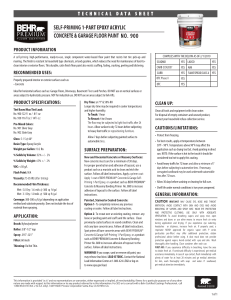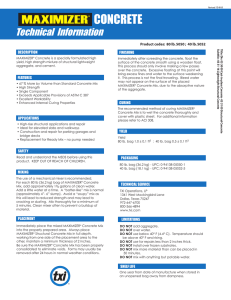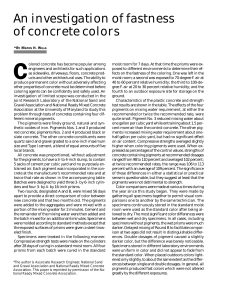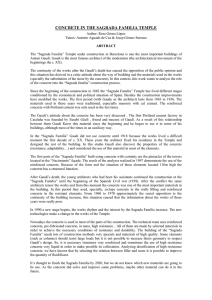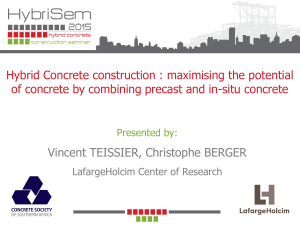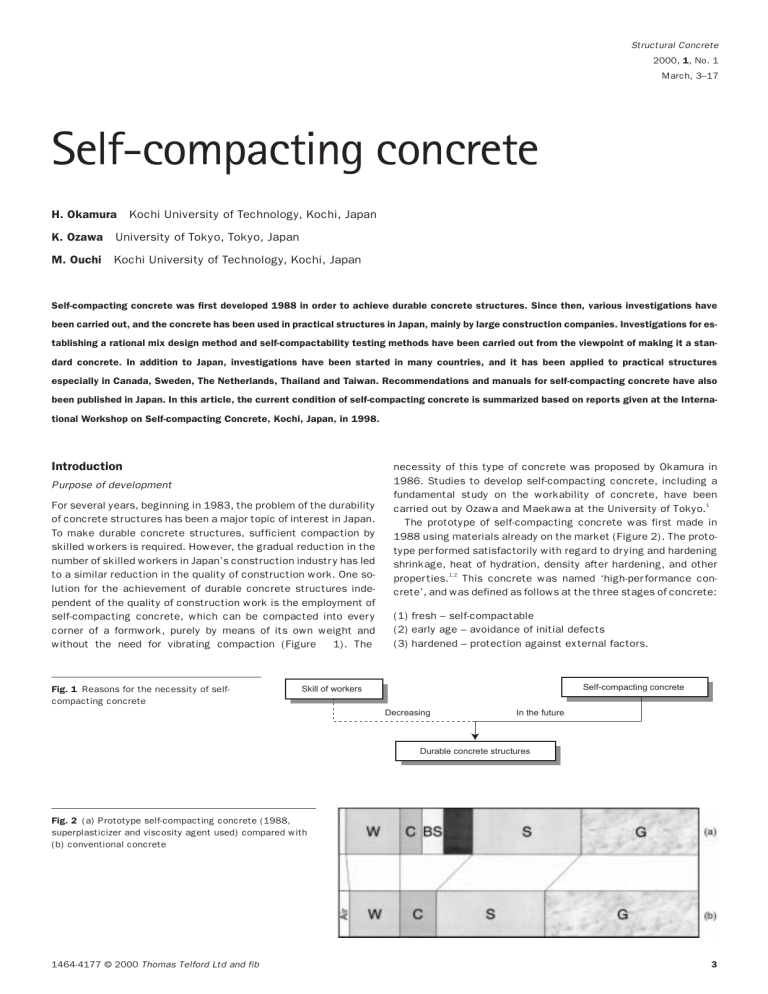
Structural Concrete 2000, 1, No. 1 March, 3–17 Self-compacting concrete H. Okamura Kochi University of Technology, Kochi, Japan K. Ozawa University of Tokyo, Tokyo, Japan M. Ouchi Kochi University of Technology, Kochi, Japan Self-compacting concrete was first developed 1988 in order to achieve durable concrete structures. Since then, various investigations have been carried out, and the concrete has been used in practical structures in Japan, mainly by large construction companies. Investigations for establishing a rational mix design method and self-compactability testing methods have been carried out from the viewpoint of making it a standard concrete. In addition to Japan, investigations have been started in many countries, and it has been applied to practical structures especially in Canada, Sweden, The Netherlands, Thailand and Taiwan. Recommendations and manuals for self-compacting concrete have also been published in Japan. In this article, the current condition of self-compacting concrete is summarized based on reports given at the International Workshop on Self-compacting Concrete, Kochi, Japan, in 1998. Introduction Purpose of development For several years, beginning in 1983, the problem of the durability of concrete structures has been a major topic of interest in Japan. To make durable concrete structures, sufficient compaction by skilled workers is required. However, the gradual reduction in the number of skilled workers in Japan’s construction industr y has led to a similar reduction in the quality of construction work. One solution for the achievement of durable concrete structures independent of the quality of construction work is the employment of self-compacting concrete, which can be compacted into ever y corner of a formwork, purely by means of its own weight and without the need for vibrating compaction (Figure 1). The Fig. 1 Reasons for the necessity of selfcompacting concrete necessity of this type of concrete was proposed by Okamura in 1986. Studies to develop self-compacting concrete, including a fundamental study on the workability of concrete, have been 1 carried out by Ozawa and Maekawa at the University of Tokyo. The prototype of self-compacting concrete was first made in 1988 using materials already on the market (Figure 2). The prototype per formed satisfactorily with regard to dr ying and hardening shrinkage, heat of hydration, density after hardening, and other 1,2 proper ties. This concrete was named ‘high-per formance concrete’, and was defined as follows at the three stages of concrete: (1) fresh – self-compactable (2) early age – avoidance of initial defects (3) hardened – protection against external factors. Self-compacting concrete Skill of workers Decreasing In the future Durable concrete structures Fig. 2 (a) Prototype self-compacting concrete (1988, superplasticizer and viscosity agent used) compared with (b) conventional concrete 1464-4177 © 2000 Thomas Telford Ltd and fib 3 Okamura et al. Limited gravel content 50% of solid volume Fig. 3 Methods for achieving self-compactability (SP, superplasticizer; w/c, water/cement ratio) Appropriate mortar Limited sand content 40% of mortar volume Proper flowability Higher dosage of SP lower w/c Proper viscosity Fig. 4 Towers of a cable-stayed bridge using selfcompacting concrete Fig. 5 Annual production of self-compacting concrete in Japan (the production of ready-mixed concrete in 30 Japan in 1997 was 167 200 000 m ) Annual production (× 1000 t) 300 200 100 0 1990 1991 1992 1993 1994 1995 1996 1997 Year 4 Structural Concrete, 2000, 1, No. 1 Self-compacting concrete At almost the same time, ‘high-per formance concrete’ was also defined as a concrete with high durability due to a low water/ 3 cement ratio by Aitcin and coworkers. Since then, the term ‘highper formance concrete’ has been used around the world to refer to high durability concrete. Therefore, we have changed the term for our proposed concrete to ‘self-compacting high-per formance concrete’. Methods for achieving self-compactability The method for achieving self-compactability involves not only high deformability of the paste or mor tar but also resistance to segregation between coarse aggregate and mor tar when the concrete flows through the confined zone of reinforcing bars. Okamura and Ozawa have employed the following methods to 4 achieve self-compactability (Figure 3): (1) limited aggregate content (2) low water/powder ratio (3) use of superplasticizer. The frequency of collision and contact between aggregate par ticles can increase as the relative distance between the par ticles decreases and then internal stress can increase when concrete is deformed, par ticularly near obstacles. It has been found that the energy required for flowing is consumed by the increased internal stress, resulting in blockage of aggregate par ticles. Limiting the coarse aggregate content, whose energy consumption is par ticularly intense, to a level lower than normal is effective in avoiding this kind of blockage. A highly viscous paste is also required to avoid the blockage of coarse aggregate when concrete flows through obstacles. When concrete is deformed, paste with a high viscosity also prevents localized increases in the internal stress due to the approach of coarse aggregate par ticles. High deformability can be achieved only by the employment of a superplasticizer, keeping the water/ powder ratio ver y low value. Spread of concept of self-compacting concrete The first paper on self-compacting concrete was presented by Ozawa at the Second East-Asia and Pacific Conference on Struc1 tural Engineering and Construction (EASEC-2) in Januar y 1989. The presentation by Ozawa at the CANMET and ACI International Conference, Istanbul, in May 1992 accelerated the spread of the 5 concept to the world. After the ACI workshop on high-per formance concrete hosted by Professor Paul Zia in Bangkok in November 1994, selfcompacting concrete became a common subject of interest for researchers and engineers interested in the durability of concrete 6 and in rational construction systems around the world. In addition, the 1996 Ferguson Lecture by Okamura at the ACI Fall Convention in New Orleans stirred up interest in self-compacting 7 concrete among researchers and engineers in Nor th America. As a result, research on self-compacting concrete star ted worldwide. These activities included investigations in Canada currently being carried out by Professor Aictin and coworkers. In Januar y 1997 the RILEM committee on self-compacting concrete was formed, and a symposium was held in Stockholm in September 1999. To put these various activities into perspective, the first international workshop on self-compacting concrete was held in Kochi, Structural Concrete, 2000, 1, No. 1 Japan, in August, 1998.8 At the workshop, the foundation of an information exchange network on self-compacting concrete using the Internet Web site ‘International Network for Self-Compacting Concrete (SCC-Net)’ was agreed. This network started in February 1999 (http://www.infra.kochi-tech.ac.jp/sccnet/). Applications of self-compacting concrete Applications in Japan Current condition on application of self-compacting concrete in Japan. After the development of the prototype self-compacting concrete at the University of Tokyo, intensive research began in many places, especially in the research institutes of large construction companies. As a result, self-compacting concrete has 9–11 The first applicanow been used in many practical structures. tion of self-compacting concrete was in a building in June 1990. Self-compacting concrete was then used in the towers of a pre12 stressed concrete cable-stayed bridge in 1991 (Figure 4). Lightweight self-compacting concrete was used in the main girder of a 13 cable-stayed bridge in 1992. Since then, the use of selfcompacting concrete in actual structures has gradually increased. Currently, the main reasons for the employment of selfcompacting concrete can be summarized as follows: (1) to shor ten construction period (2) to assure compaction in the structure: especially in confined zones where compaction by vibrator is difficult (3) to eliminate noise due to vibration. The volume of self-compacting concrete used in Japan since 1990 is shown in Figure 5. The production of self-compacting concrete is currently only 0.1% of the total Japanese ready-mixed 14 concrete production. The current status of self-compacting concrete is as ‘special concrete’ rather than ‘standard concrete’. Examples of the application of self-compacting concrete are summarized below: • • • • • • • • • • bridges (anchorages, arches, beams, towers, joints) box culver t building concrete-filled steel column tunnel (lining, immersed tunnel, filling of sur vey tunnel) dam (concrete around structure) concrete products (blocks, culver ts, walls, water tanks, slabs and segments) diaphragm wall tank (side wall, joint between side wall and slab) pipe roof. Large-scale construction. Self-compacting concrete is currently being used to shor ten the construction period of large-scale constructions. The anchorages of Akashi-Kaikyo (Straits) Bridge opened in April 1998, a suspension bridge with the longest span in the world 15 (1991 m), is a typical example (Figure 6). Self-compacting concrete was used in the construction of the two anchorages of the bridge. A new construction system, which makes full use of the per formance of self-compacting concrete, was introduced for this. The concrete was mixed at a batching plant beside the site and was pumped 200 m through pipes to the casting site, where the pipes were arranged in rows 3–5 m apar t. The concrete was cast from gate valves located at 5 m inter vals along the pipes. 5 Okamura et al. These valves were automatically controlled so that a surface level of the cast concrete could be maintained. The maximum size of the coarse aggregate used at this site was 40 mm. The concrete fell as much as 3 m without segregation, despite the large size of coarse aggregate. In the final analysis, the use of self-compacting concrete shortened the anchorage construction period by 20%, from 2.5 to 2 years. Self-compacting concrete was used for the wall of a large LNG 16 tank belonging to the Osaka Gas Company. The adoption of selfcompacting concrete meant that: (1) the number of pours decreased from 14 to 10, as the height of each pour was increased (2) the number of concrete workers was reduced from 150 to 50 (3) the construction period for the structure decreased from 22 to 18 months. In addition, a rational acceptance test for self-compactability at the site was introduced (Figure 7). The concreting was completed in June 1998. Concrete products. Self-compacting concrete is now often employed in concrete products to eliminate the noise of vibration 17 (Figure 8). This improves the working environment at plants and makes it possible for the plants to be located in urban areas. In addition, use of self-compacting concrete increases the lifetime of the moulds. The production of concrete products using self14 compacting concrete has been gradually increasing (Figure 9). Fig. 6 Anchorage 4A of the Akashi-Kaikyo Bridge Fig. 7 Acceptance testing apparatus on site, installed between an agitator truck and pump 6 Structural Concrete, 2000, 1, No. 1 Self-compacting concrete Applications around the world With the spread of the concept around the world, investigations on self-compacting concrete and applications in practical structures have been repor ted. The following information on current conditions in each countr y was summarized at the International 8 Workshop on Self-Compacting Concrete, Kochi, Japan, in 1998. Canada. Investigations on self-compacting concrete in Canada star ted in 1992 under the leadership of the University of Sherbrooke, relating to high-per formance concrete. Selfcompacting concrete was used in the repair of a severely damaged beam in an external parking garage; rehabilitation of restricted slab and wall elements in a hydroelectric power plant, construction of two experimental basement walls and construction of a strong reaction wall for structural testing. The most promising markets for self-compacting concrete in Canada are: (1) basements – 25% of market for concrete in Canada (2) rehabilitation (3) ‘silent concrete’ in urban area. Sweden. Self-compacting concrete technology for bridge applications has been developed in a joint project between a contractor and a research institute. During early 1998 three bridges were cast with encouraging results, and fur ther bridge applications are planned. In an EU project on industrialization of concrete construction, self-compacting concrete for house building is being developed, and the first applications have been carried out, using self-compacting concrete with fibre. In addition, training activities on mix design, material production and testing methods were also carried out, and all major mixed concrete plants in Sweden are already producing self-compacting concrete. The Netherlands. In the period 1995–1996 early experience was gained with self-compacting concrete in The Netherlands. After Fig. 8 Casting of self-compacting concrete for a tunnel segment 300 Annual production (× 1000 t) Fig. 9 Annual production of concrete products using self-compacting concrete in Japan 200 100 0 1990 1991 1992 1993 1994 1995 1996 1997 Year Structural Concrete, 2000, 1, No. 1 7 Okamura et al. Initial mix proportion Material parameter Test 3 Fig. 10 Types of self-compactability evaluation for mix proportioning and inspection Trial mixing Adjust mix proportion Test 1 Selfcompactability No Test 2 Yes End Fig. 11 U test (dimensions in mm) Open the centre gate 680 mm Centre gate Obstacle 200 mm Height 280 mm the Japanese mix design method was introduced in 1997, it was shown that self-compacting concrete with segregation resistance could be made using Dutch materials. Self-compacting concrete was applied to a building in 1997. In addition, in 1998, the Dutch Precast Concrete Industry formed a research group to study the application of self-compacting concrete in concrete products. (1) concrete-filled steel columns for high-rise buildings (2) an overpass in a highway interchange (3) a bus-privileged driveway (4) buildings. Thailand. Self-compacting concrete has been used in practical structures in Thailand since 1992. Since only 10% of the available fly ash is currently utilized in Thailand, the use of self-compacting concrete is seen as one way to use this resource. Some examples of the application of self-compacting concrete in Thailand are: Other countries. Investigations into self-compacting concrete have also been repor ted from the USA, Austria, the UK, France, Korea and Iceland. (1) the water supply structure for a cooling tower in a coal 3 generating plant – 4000 m (2) an overpass in an expressway project – 432 m3 (3) steel composite long columns in an office building – 429 m3. Taiwan. Investigation on self-compacting concrete star ted in Taiwan in 1994 and, since then, there have been many applications in practical structures due to the increasing demand for con18 struction and the shor tage of skilled workers. Some examples are: 8 In addition, self-compacting concrete will be employed in the Taiwan high-speed railway project. State of the art of self-compacting concrete Current status of self-compacting concrete Self-compacting concrete has been used as a ‘special concrete’ only by large general construction companies in Japan. In order for self-compacting concrete to be used as a standard concrete rather than a special one, new systems for the design, manufacture and construction of self-compacting concrete need to be established, and a number of organizations, both within Japan and internationally, have set up committees to develop guidance. Among them, a system by which the ready mixed concrete industry can produce self-compacting concrete as a normal Structural Concrete, 2000, 1, No. 1 Self-compacting concrete concrete would seem the most effective since, in Japan, as much as 70% of the total concrete produced is from the ready mixed concrete industry. Assuming general supply from ready mixed concrete plants, investigations to establish the following items have been carried out mainly at the University of Tokyo: (1) self-compactability testing (2) mix design (3) acceptance testing on site. The first book on self-compacting concrete, High Per formance Concrete, written by Okamura et al., was published in 1993.19 Self-compactability evaluation There are three requirements for self-compactability tests, as shown in Figure 10: • • • test 1 – to check self-compactibility test 2 – to adjust the mix proportion when self-compactability is not sufficient test 3 – to evaluate materials. To check self-compactibility. As a test for mix propor tioning in the laborator y (i.e. test 1), the so-called U test or box test 20 (Figures 11, 12 and 13) is recommended. The U test was developed by Taisei’s group. In this test, the degree of compactability can be indicated by the height that the concrete reaches after flowing through an obstacle. The obstacle with the highest requirements should be chosen. Concrete with a filling height of over 300 mm can be judged to be self-compacting. The box test is more suitable for detecting concrete with a higher possibility of segregation between coarse aggregate and mor tar. To adjust mix proportions. If the concrete is judged to have insufficient self-compactability with test 1, the cause has to be established quantitatively so that the mix propor tions can be adjusted. Slump flow and funnel tests ( Figure 14) have been Fig. 12 Box test Fig. 13 Obstacles for the U or box test (left, R2; right, R1) Structural Concrete, 2000, 1, No. 1 9 Okamura et al. proposed for testing the deformability and viscosity. These give the indices Gc and Rc, defined as follows: Gc = (Sfl1Sfl2 – Sfl02)/Sfl02 where Sfl1 and Sfl2 are measured flow diameters and Sfl0 is the slump cone diameter, and Rc = 10/t where t is the measured time (in seconds) for concrete to flow through the funnel. To evaluate materials. Flow and funnel tests for mor tar or paste have been proposed for evaluating materials used in selfcompacting concrete, e.g. powder material, sand and superplasticizer. Testing methods for mor tar proper ties have been proposed which give the indices Gm and R m for deformability and 21 viscosity, respectively (Figures 15 and 16): G m = (d1d2 – d02)/d02 where d1 and d2 are measured flow diameters and d0 is the flow cone diameter, and R m = 10/t where t is the measured time (in seconds) for mor tar to flow through the funnel Larger Gm values indicate higher deformability and smaller Rm values indicate higher viscosity. Evaluation criteria for materials 3,4 were proposed in terms of Gm and Rm. Fig. 14 V funnel Mix design method Relative flow area Gm = (d 1d 2 – d 02)/d 02 (1) the coarse aggregate content in concrete is fixed at 50% of the solid volume. (2) the fine aggregate content is fixed at 40% of the mor tar volume. (3) the water/powder ratio is assumed to be 0.9–1.0 by volume, depending on the proper ties of the powder. (4) the superplasticizer dosage and the final water/powder ratio are determined so as to ensure self-compactability. 60 mm 70 mm Flow cone Rational mix design method. Self-compactability can be largely affected by the characteristics of materials and the mix propor tion. A rational mix design method for self-compacting concrete using a variety of materials is necessar y. Okamura and Ozawa have proposed a simple mix-propor tioning system assuming a 4 general supply from ready mixed concrete plants. The coarse and fine aggregate contents are fixed so that self-compactability can be achieved easily by adjusting the water/powder ratio and superplasticizer dosage only: d 0: 100 mm d1 d2 Fig. 15 Mortar flow test and the index Gm 10 In the mix propor tioning of conventional concrete, the water/ cement ratio is fixed at first from the viewpoint of obtaining the required strength. With self-compacting concrete, however, the water/powder ratio has to be decided taking self-compactability into account because self-compactability is ver y sensitive to this ratio. In most cases, the required strength does not govern the water/cement ratio because the water/powder ratio is small enough to give the required strength for ordinar y structures unless most of the powder materials in use are not reactive. The mor tar or paste in self-compacting concrete requires high viscosity as well as high deformability. This can be achieved by Structural Concrete, 2000, 1, No. 1 Self-compacting concrete the employment of a superplasticizer, which results in a low water/powder ratio for high deformability. These formulae can be used for establishing a rational method for adjusting the water/powder ratio and superplasticizer dosage for achieving appropriate deformability and viscosity. Adjustment of the water/powder ratio and superplasticizer dosage. The characteristics of the powder and superplasticizer largely affect the mor tar proper ty, and so an appropriate water/ powder ratio and superplasticizer dosage cannot be fixed without trial mixing at this stage. Therefore, once the mix propor tion has been decided on, self-compactability has to be tested by the Utype, slump–flow and funnel tests. Methods of judging whether the water/powder ratio or superplasticizer dosage is larger or smaller than the required value by using the test results, and of estimating the required values, are necessar y. The relationships between the proper ties of the mor tar in self-compacting concrete and the mix propor tion have been investigated and formulated. Evaluation of materials with mortar or paste tests Evaluation of materials is ver y impor tant for self-compacting concrete since the characteristics of the materials greatly affect the self-compactability of fresh concrete. It is also desirable that the appropriate mix propor tion can be estimated with a minimum number of trial mixings. Dispersing effect of the superplasticizer. It was found that the ratio of Gm to Rm is almost constant with variation of Vw/Vp (volume ratio of water to powder) provided that Sp/P (the weight ratio of 270 mm Fig. 16 Mortar funnel test and the index Rm 240 mm 30 mm 60 mm Relative funnel speed Rm = 10/funnel time (seconds) 30 mm Fig. 17 Relationship between Gm and Rm of mortar (sand content 40% by volume, moderate heat cement, Sp/P fixed on the line) Sp/P= 0.8% 1.0% 1.2% 1.4% 2 92 Vw/Vp: % Rm 1 88 86 88 88 90 86 86 80 78 80 77 78 80 76 85 82 84 84 82 90 74 76 1.6% 80 78 1.8% 79 76 74 75 72 0 0 2 4 6 8 10 Gm Structural Concrete, 2000, 1, No. 1 11 Okamura et al. Fig. 18 Index for the effect of superplasticizer: Gm/ Rm Rm Sp/P= 0 Large 0 Gm 12 Fig. 19 Relationship between Sp/P and Gm/Rm (sand content 40% in mortar; MC, moderate heat cement (BS 4000); blast furnace slag with a Blaine value of 4000; FA, fly ash; SP, superplasticizer) BS 4000 + SP-A 10 FA + SP-B Gm/Fm 8 MC + SP-B MC + SP-A 6 4 2 0 0 1.0 0.5 1.5 2.0 Sp/P (%) Vw/Vp = 88% 2 Sp/P (%) 1.0 Fig. 20 Relationship between Gm and Rm (sand content 40% by volume, moderate heat cement, Vw/Vp fixed on the cur ve) 1.2 84% 1.2 Rm 1.0 0.8 1.2 1.0 0.8 0.8 1.4 1.0 1.0 1.6 1.4 1.2 1.4 1.0 1.6 80% 1.4 1.2 1 1.4 1.6 1.6 1.6 1.6 1.8 76% 1.8 1.6 1.8 1.2 0 0 2 4 6 8 10 Gm 12 Structural Concrete, 2000, 1, No. 1 Self-compacting concrete High 2 Rm = AGm0·4 A Vw/Vp Rm Linear relationship 1 Low 0 0 2 4 6 8 Inclination 10 Gm Vw/Vp Fig. 21 Relationship between Vp/Vw and Rm/Gm 1.0 0.8 0.4 1.0 0.8 Inclination: 3.9 0.6 Inclination: 4.0 0.6 A A 0.4 0.4 0.2 0 65 0.2 MC + SP-8S(B) MC + SP-8N(X3) 0 70 75 80 85 90 95 65 70 75 Vw /Vp (%) 80 85 90 95 Vw /Vp (%) 1.0 1.0 0.8 0.8 Inclination: 3.7 Inclination: 6.1 0.6 0.6 A A 0.4 0.4 0.2 0 60 0.2 BS 4000 + SP-8S(X3) 65 70 75 80 85 90 0 35 Vw /Vp (%) superplasticizer to powder) is constant (Figure 17).21 The gradient of the Gm–Rm line corresponding to each Sp/P indicates the effect of superplasticizer, which is independent of Vw/Vp. This is effective in evaluating Sp/P by using only one pair of experimental results (Gm, Rm). In this study, Gm/Rm is proposed as the index for the effect of superplasticizer from the viewpoint of achieving both deformability and viscosity at the combination of powder material used. Larger values of Gm/Rm indicate a greater effect of superplasticizer, that is, higher deformability (Gm) without decrease of viscosity (1/R m) (Figure 18). The relationship between Sp/P and Gm/Rm is significantly affected by the combination of superplasticizer and powder material used (Figure 19). At this stage, the relationship cannot be estimated without tests due to the chemical effect of superplasticizer depending on combination with the par ticular powder material used. Structural Concrete, 2000, 1, No. 1 FA + SP-8N(X3) 40 45 50 55 60 65 Vw /Vp (%) 0.4 Fig. 22 Relationship between Vp/Vw and Rm/Gm for variation in powder materials (sand content 40% by volume; SP, superplasticizer) Particles in mortar: flowability. The relationship between Gm and Rm with variation of Sp/P for constant Vw/Vp has already been pro21 posed (Figures 20 and 21): Rm = A Gm0.4 where A = K(Vw/Vp), i.e. a linear relationship exists between A and Vw/Vp The relationships between Vw/Vp and A for mor tar with variation of the powder materials are shown in Figure 22. It was found that the gradient depends on the proper ty of the solid par ticles in the mortar. The gradient for fly ash mortar is the largest, and the 13 Okamura et al. Rmb (funnel speed of mortar with coarse aggregate) Acceptance test on site Small Degree of interaction Large Rm (funnel speed of mortar) Fig. 23 Index Rmb/Rm for the degree of interaction of mortar with coarse aggregate Since the degree of compaction in a structure depends mainly on the self-compactability of the concrete, and poor selfcompactability cannot be compensated by the construction work, self-compactability must be checked for all concrete just before casting. However, conventional testing methods for selfcompactability require sampling, and this can be extremely laborious if the self-compactability acceptance test is to be carried out for the whole batch of concrete. A suitable acceptance test method for self-compactability has been developed by Ouchi and coworkers:8 (1) The testing apparatus is installed between the agitator truck and the pump at the site. The whole of the concrete batch is poured into the apparatus. (2) If the concrete flows through the apparatus, the concrete is considered to be self-compactable. If the concrete is stopped by the apparatus, the concrete is considered as having insufficient self-compactability, and mix propor tion has to be adjusted. This apparatus was successfully used at the construction site of the Osaka Gas LNG tank, and saved a considerable amount of acceptance test work (Figure 26).16 New structural design and construction systems gradients for mortar with ordinary powder having Blaine values of 3000–4000 cm2/g are almost the same: around 4. It also found that the gradient is independent of the type of superplasticizer used. Particles in mortar: interaction with coarse aggregate. A testing method for the interaction between coarse aggregate and mor tar par ticles in self-compacting concrete was proposed in which the ratio of funnel speed of the mor tar with model coarse aggregate and that without model coarse aggregate is com22 pared. The conventional funnel for mor tar in self-compacting concrete was adopted as the testing apparatus. Glass beads with a diameter of 10 mm were adopted as the model coarse aggregate, and the content of the model coarse aggregate was chosen as 20% of the total mor tar volume so that blocking cannot occur easily. The index for the interaction was proposed as the ratio of the funnel speed of mor tar with glass beads (Rmb) to that without glass beads (Rm) (Figure 23). It was found out that the ratio Rmb/ Rm was constant provided that the deformability or viscosity of mor tar itself is within the range necessar y for achieving selfcompactability. It is possible that this test can be substituted for the self-compactability test for examining the sand content in the mor tar (Figures 24 and 25). By employing self-compacting concrete, the cost of compaction can be saved and the compaction of the concrete in the structure can be assured. However, the total construction cost cannot always be reduced, except for large-scale constructions. This is because the conventional construction system is strongly based on the necessity of the vibrating compaction of concrete. Self-compacting concrete can greatly improve construction systems previously based on conventional concrete requiring vibrating compaction. This sor t of compaction, which can easily cause segregation, has been an obstacle to the rationalization of construction work. Once this obstacle has been eliminated, concrete construction can be rationalized, and a new construction system, including formwork, reinforcement, suppor t and structural design, can be developed One example of a novel design is the so-called sandwich structure, where a steel shell is filled with concrete. This type of structure has already been built in Kobe, and could not have been achieved without the development of self-compacting concrete (Figure 27).29 Recommendations and manuals A set of manuals on self-compacting concrete has been published by different organizations in Japan. At present, the following are available: Segregation-inhibiting agent It has been found possible to manufacture self-compacting concrete with constant quality, especially self-compactability. However, any variation in material characteristics can affect the self-compactability. The most influential variant is the water content of the fine aggregate, which results in variations in the water content of the concrete itself. To solve this problem, some general construction companies employ a segregation-inhibiting agent. This type of agent is effective in making selfcompactability less sensitive to variations in the water content. 23–28 Various agents have been proposed and are available in Japan. 14 • • • Recommendations for Mix Design and Construction Practice of Highly Fluidity Concrete (The Architectural Institute of Japan). Recommendations for Self-Compacting Concrete (The Japan Society of Civil Engineers). Manual for Manufacturing Self-Compacting Concrete (The National Ready-Mixed Concrete Industr y Association, Japan). All of these are available in the proceedings of the International Workshop on Self-Compacting Concrete held in Kochi in March 8 1999. Structural Concrete, 2000, 1, No. 1 Self-compacting concrete 0.8 Fig. 24 Relationships between sand content in mortar (v/v) and Rmb/Rm: 1, OPC (ordinar y Portland cement) + CS (crushed sand); 2, FA (fly ash) + CS; 3, FA + RS (river sand); 4, OPC + RS; 5, OPC + MS (mountain sand) 5 0.7 4 3 Rmb/Rm 1 0.6 2 0.5 0.2 0.3 0.4 0.5 0.6 Sand content in mortar Fig. 25 Unique relationship between Rmb/Rm and filling height of the box test (obstacle R1) independent of the characteristics of the powder or sand (see Figure 24 for definitions of abbreviations) Filling height (mm) 300 200 OPC + RS OPC + CS 100 OPC + MS FA + RS FA + CS 0 0.5 0.6 0.7 0.8 Rmb/Rm Fig. 26 Acceptance testing apparatus used on site (dimensions in mm) 0 40 100 300 300 300 60 150 200 Concrete 520 Structural Concrete, 2000, 1, No. 1 15 Okamura et al. Fig. 27 Sandwich structure for an immersed tunnel Conclusions Since both a rational mix design method and an appropriate acceptance testing method at the job site are close to being established for self-compacting concrete, it is considered that the main obstacles to the wide use of self-compacting concrete have been removed. The next task is to distribute the techniques for manufacturing and construction of self-compacting concrete rapidly. Rational training and qualification systems for engineers should be introduced. In addition, new structural design and construction systems making full use of the benefits of self-compacting concrete should be introduced. Once self-compacting concrete becomes so widely used that it is seen as a ‘standard concrete’ rather than as a ‘special concrete’, we will have succeeded in creating durable and reliable concrete structures requiring ver y little maintenance work. References 1. Ozawa, K., Maekawa, K., Kunishima, M. and Okamura, H. Development of high per formance concrete based on the durability design of concrete structures. Proceedings of the 2nd East-Asia and Pacific Conference on Structural Engineering and Construction (EASEC-2), 1989, Vol. 1, pp. 445–450. 2. Maekawa, K. and Ozawa, K. Development of SCC’s prototype. SelfCompacting High Per formance Concrete, Social System Institute, Tokyo, 1999, pp. 20–32 [in Japanese]. 3. Gagne, R., Pigeon, M. and Aitcin, P. C. Decier salt scaling resistance of high per formance concrete. Paul Klieger Symposium on Per formance of Concrete, SP-122. American Concrete Institute, Detroit, 1989. 4. Okamura, H. and Ozawa, K. Mix design for self-compacting concrete. Concrete Librar y of the JSCE, 1995, No. 25, pp. 107–120. 5. Ozawa, K., Tagtermsirikul, S. and Maekawa, K. Role of materials on the filling capacity of fresh concrete. Proceedings of the 4th CANMET and ACI International Conference on Fly Ash, Silica Fume, Slag and Natural Pozzolans in Concrete. Istanbul, 1992, pp. 212–237. 6. Okamura, H. and Ozawa, K. Self-compactable High-per formance Concrete In Japan, SP-169. American Concrete Institute, Detroit, 1994, pp. 31–44. 7. Okamura, H. Ferguson lecture for 1996: Self-compacting highper formance concrete. Concrete International, 1997, 19, No. 7, 50–54. 16 8. Ozawa, K. and Ouchi, M. (eds). Proceedings of the International Workshop on Self-Compacting Concrete, CD-ROM. Kochi, 1999. [Includes state-of-the-art report on self-compactability evaluation, materials and design, construction, manufacturing and concrete products and summar y of recommendations and manuals for selfcompacting concrete in Japan. Also available from Concrete Engineering Series, No. 30, Japan Society of Civil Engineers, 1999.] 9. Yamada, K. Challenge for Application of SCC to Practical Structures. Self-compacting High Per formance Concrete, Social System Institute, 1999, pp. 34–80 [in Japanese]. 10. Tanaka, K. Development of Low-heat SCC for Anchorage 4A of AkashiKaikyo Bridge. Self-compacting High Per formance Concrete, Social System Institute, Tokyo, 1999, pp. 82–110 [in Japanese]. 11. Matsuoka, Y. Progress to Application of SCC to Practical Structures. Self-compacting High Per formance Concrete, Social System Institute, 1999, Tokyo, pp. 112–160 [in Japanese]. 12. Sakamoto, J., Matsuoka, Y., Shindoh, T. and Tangtermsirikul, S. An application of super workable concrete to construction of actual structures. Transactions of the Japan Concrete Institute, 1991, 13. 13. Ohno, H., Kawai, T., Kuroda, Y. and Ozawa, K. Development of vibration-free high strength lightweight concrete and its application. Proceeding of FIP Symposium. Kyoto, 1993, vol. 1, pp. 297–304. 14. Kodama, Y. Current condition of SCC’s application. Cement Shimbun, No. 2304, 1997 [in Japanese]. 15. Kashima, S., Kanazawa, K., Okada, R. and Yoshikawa, S. Application of self-compacting concrete made with low-heat cement for bridge substructures of Honshu-Shikoku Bridge Authority. Proceedings of the International Workshop on Self-Compacting Concrete, 1999, pp. 255–261. 16. Kitamura, H., Nishizaki, T., Ito H., Chikamatsu, R., Kamada, F. and Okudate, M. Construction of prestressed concrete outer tank for LNG storage using high-strength self-compacting concrete. Proceedings of the International Workshop on Self-Compacting Concrete, 1999, pp. 262–291. 17. Uno, Y. State-of-the art report on concrete products made of SCC. Proceedings of the International Workshop on Self-Compacting Concrete, 1999, pp. 262–291. 18. Chern, J. C. The recent developments and applications of SQC in Taiwan. Proceedings of The Symposium on Super Quality Concrete 1998, pp. 1–16. 19. Okamura, H., Maekawa, K. and Ozawa, K. High Per formance Concrete. Gihodo, 1993. 20. Hayakawa, M., Matsuoka, Y. and Shindoh, T. Development and application of super workable concrete. RILEM International Workshop on Special Concretes: Workability and Mixing. Paisley, 1993. Structural Concrete, 2000, 1, No. 1 Self-compacting concrete 21. Ouchi, M., Hibino, M., Ozawa, K. and Okamura, H. A rational mixdesign method for mortar in self-compacting concrete. Proceedings of the 6th East Asia-Pacific Conference on Structural Engineering and Construction. Taipei, ROC, 1998, vol. 2, pp. 1307–1312. 22. Ouchi, M. and Edamatsu, Y. A simple evaluation method for interaction between coarse aggregate and mortar particles in self-compacting concrete. Proceedings of RILEM SCC Symposium. Stockholm, 1999. 23. Hibino, M., Okuma, M. and Ozawa, K. Role of viscosity agent in selfcompactability of fresh concrete. Proceedings of the 6th East-Asia Conference on Structural Engineering and Construction. Taipei, 1998, vol. 2, pp. 1313–1318. 24. Kawai, T. and Okada, T. Effect of superplasticizer and viscosityincreasing admixture on properties of lightweight aggregate concrete. 3rd CANMET/ACI International Conference on Superplasticizers and Other Chemical Admixture in Concrete, SP-119. American Concrete Institute, Detroit, 1989, pp. 583–604. 25. Shindoh, T., Matsuoka, Y., Tangtermsirikul, S. and Sakamoto, J. Effect of variation of material quality on properties of super workable concrete. Transactions of the Japan Concrete Institute, 1992, 14. 26. Kawai, T. Integrated Design and Environmental Issues in Concrete Technology. Spon, London, 1996. 27. Sakata, N., Maruyama, K. and Minami, M. Production Methods and Workability of Concrete. Spon, London, 1996. 28. Matsuoka, Y., Shindoh, T., Yokota, K. and Kusui, S. Property of Beta1,3-gurcan (Curdlan) as a Viscosity Agent for Super-workable Concrete, SP-173. American Concrete Institute, Detroit, 1997. 29. Shishido, T., Shiraiwa, S., Ishii, J., Yamamoto, S. and Kume, H. Pouring works of highly fluidity concrete for immersed tunnel by steel-concrete composite structure. Proceedings of the International Workshop on Self-Compacting Concrete, CD-ROM. Kochi, 1999, pp. 328–346. Structural Concrete, 2000, 1, No. 1 H. Okamura, Dr Eng. Kochi University of Technology, Tosa-Yamada, Kochi 782-8502, Japan K. Ozawa, Dr Eng. University of Tokyo, Tokyo, Japan M. Ouchi, Dr Eng. Kochi University of Technology, Tosa-Yamada, Kochi 782-8502, Kochi, Japan 17




